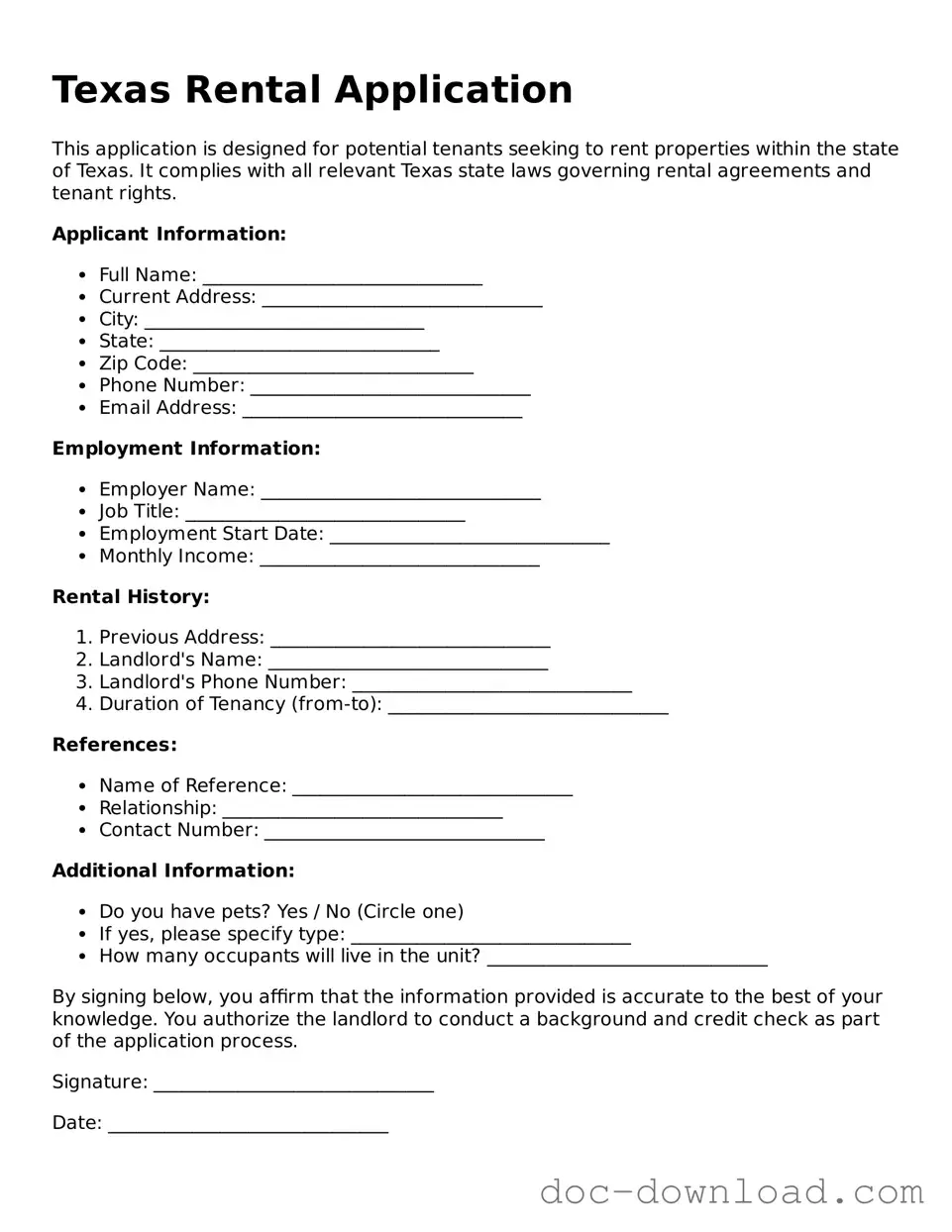The Texas Rental Application form shares similarities with the standard Lease Application form used across many states. Both documents collect essential information from prospective tenants, such as personal details, rental history, employment information, and references. This information helps landlords assess the suitability of applicants. The Lease Application may vary slightly in format or specific questions but serves the same purpose of evaluating potential tenants before entering into a lease agreement.
Another document similar to the Texas Rental Application is the Tenant Screening Application. This form often includes more in-depth questions about an applicant's financial history and may require consent for background checks. While the Texas Rental Application primarily focuses on basic tenant information, the Tenant Screening Application delves deeper into an applicant's creditworthiness and rental behavior, providing landlords with a more comprehensive view of the applicant.
The Rental History Verification form closely resembles the Texas Rental Application. This document is typically filled out by previous landlords to verify an applicant's rental history. While the Texas Rental Application requests this information directly from the applicant, the Rental History Verification form seeks to confirm the accuracy of the details provided. Both documents are crucial in establishing a potential tenant's reliability and past behavior as a renter.
Understanding the various application forms is essential for both landlords and tenants to ensure compatibility and compliance. The Texas Rental Application, for instance, is pivotal in assessing a potential tenant's qualifications, while other documents like the Employment Application Form and Guarantor Application serve specific roles in financial assessments. Business owners in Colorado also need to pay attention to foundational documents such as the Operating Agreement form, which can be obtained from resources like Colorado PDF Forms. This document helps structure relationships and operations within a limited liability company, reinforcing the importance of having a tailored agreement instead of relying solely on default state laws.
The Employment Verification form is another document that parallels the Texas Rental Application. This form is used to confirm an applicant's employment status and income level. While the Texas Rental Application may ask for employment details, the Employment Verification form requires direct communication with the applicant's employer. This process ensures that the applicant has a stable income, which is a key factor in determining their ability to pay rent.
The Background Check Authorization form is also similar to the Texas Rental Application. This document grants landlords permission to conduct background checks on potential tenants. While the Texas Rental Application may include a section for background checks, the Background Check Authorization form specifically outlines the applicant's consent, detailing what information will be accessed and how it will be used in the decision-making process.
The Credit Application form is akin to the Texas Rental Application in that it focuses on the financial aspect of an applicant. This form is often used by landlords to assess an applicant's credit history and score. While the Texas Rental Application collects basic financial information, the Credit Application provides a more detailed analysis of the applicant's creditworthiness, which is vital for landlords in making informed leasing decisions.
The Guarantor Application form can also be compared to the Texas Rental Application. This document is completed by a third party who agrees to take financial responsibility for the lease if the tenant fails to pay. Like the Texas Rental Application, the Guarantor Application collects personal and financial information, but it focuses on the guarantor's ability to cover the tenant's obligations, thereby providing an additional layer of security for landlords.
The Pet Application form is another document that parallels the Texas Rental Application, particularly for pet-friendly rentals. This form collects information about the applicant's pets, including breed, size, and vaccination status. While the Texas Rental Application may include a section about pets, the Pet Application provides a more detailed overview, allowing landlords to assess any potential risks or concerns associated with allowing pets in their property.
The Move-In Checklist is similar to the Texas Rental Application in that it serves as a record-keeping tool for both landlords and tenants. While the Texas Rental Application focuses on tenant information, the Move-In Checklist documents the condition of the rental property at the time of move-in. This checklist helps prevent disputes over security deposits and ensures that both parties are aware of the property's condition before the lease begins.
Finally, the Lease Agreement itself has similarities with the Texas Rental Application. Both documents are essential in the rental process, but they serve different purposes. The Texas Rental Application gathers information to evaluate potential tenants, while the Lease Agreement outlines the terms and conditions of the rental arrangement once an applicant has been approved. Both documents are critical in establishing a clear understanding of the rental relationship.
